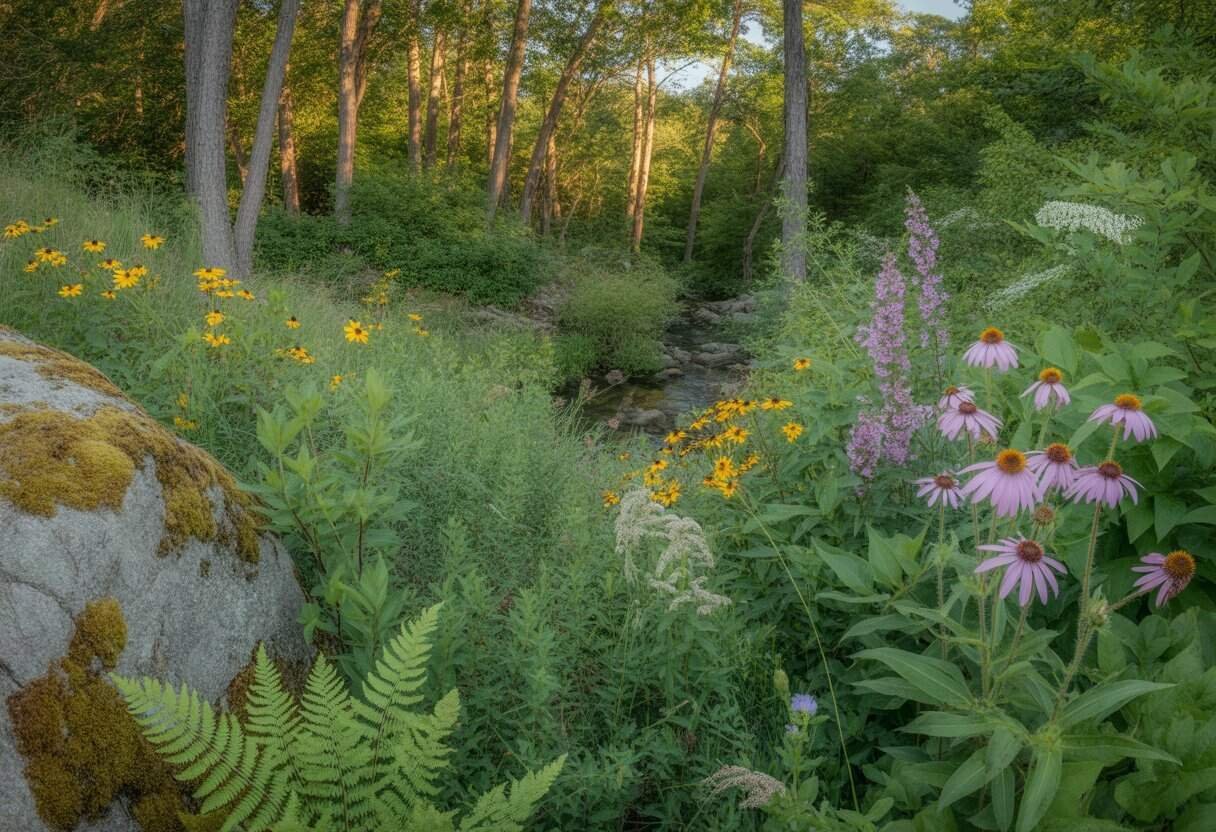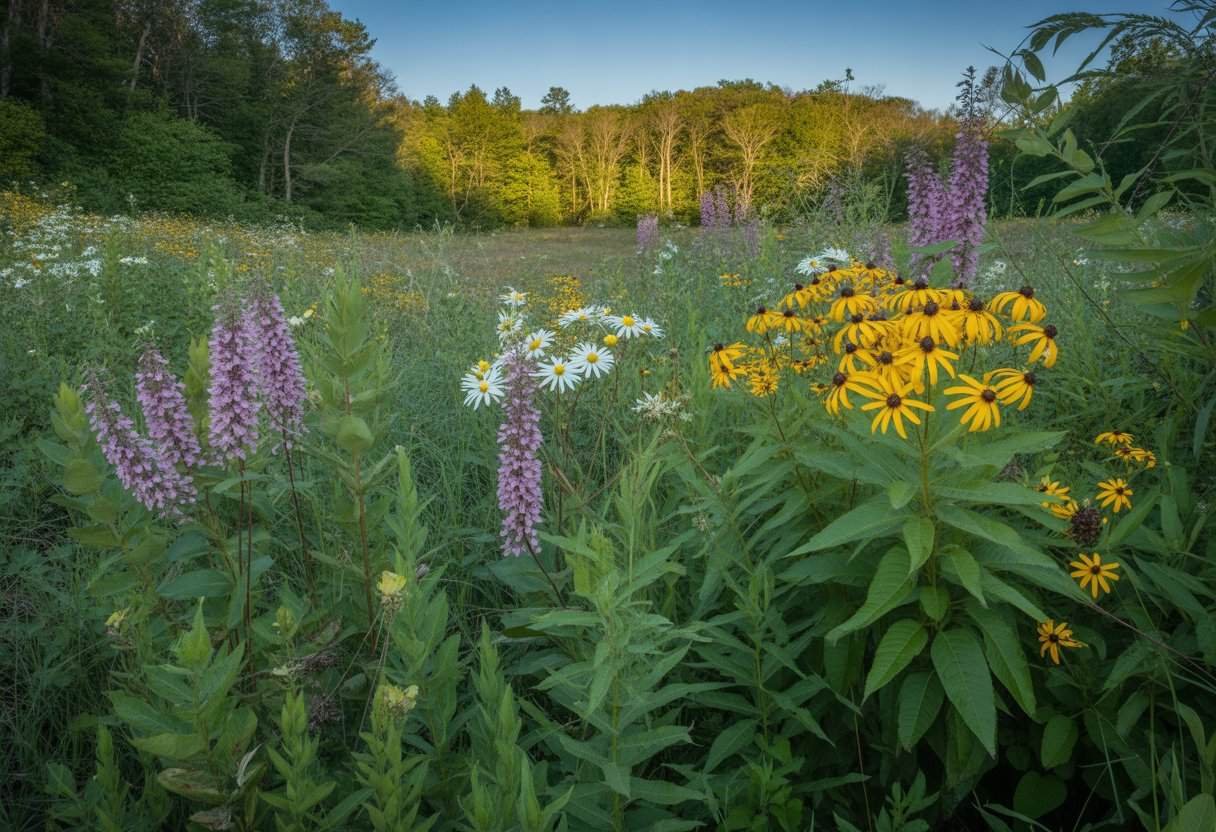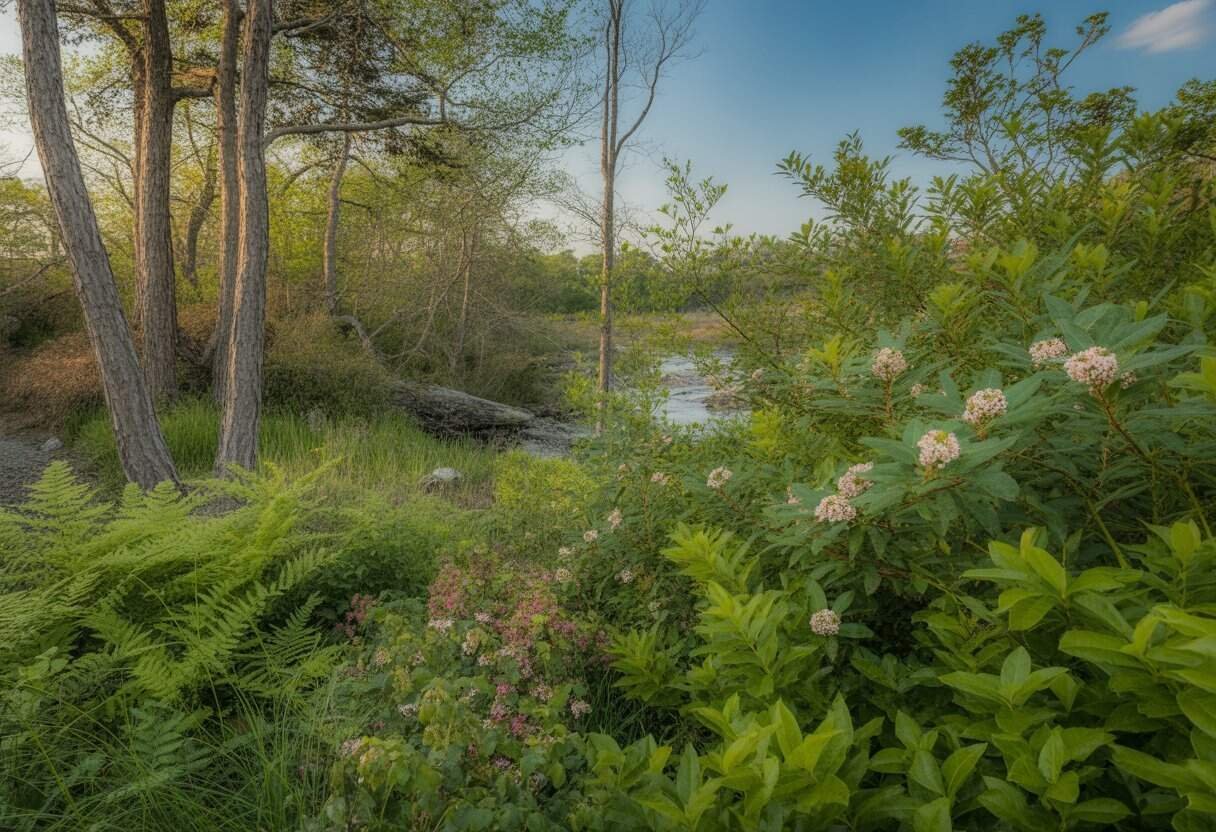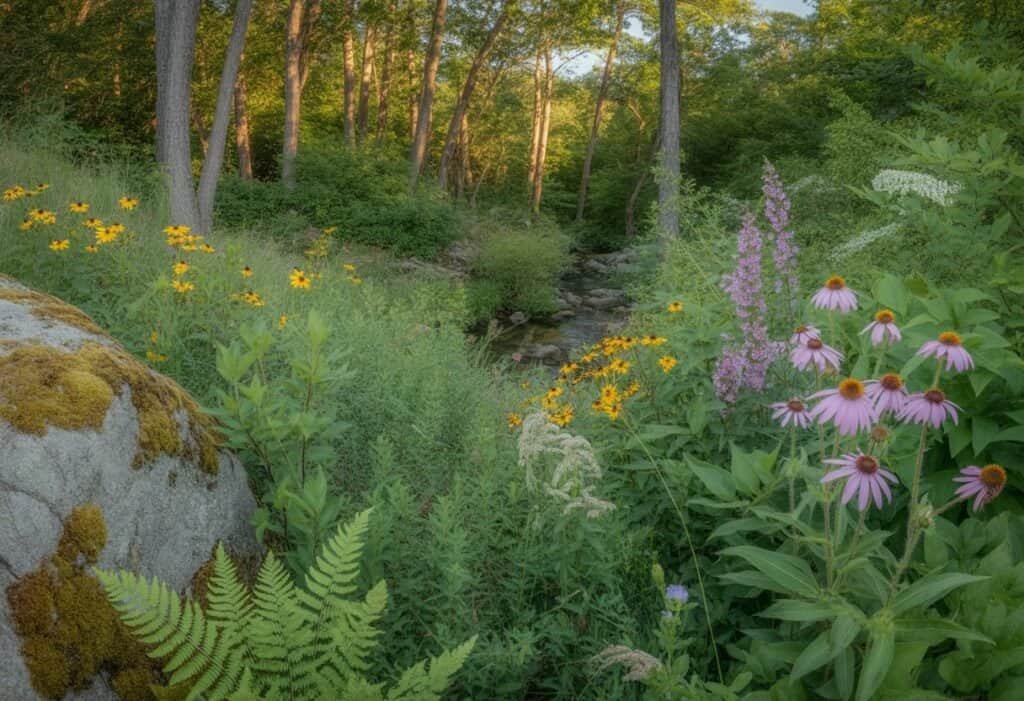Native plants form the backbone of Massachusetts’ diverse ecosystems. They thrive in our unique climate and support local wildlife.
These plants evolved in our region over thousands of years. They adapt perfectly to local soil, rainfall, and seasonal changes.
Unlike non-native species, native plants need less maintenance once established.

Growing native plants in Massachusetts gardens supports local pollinators, conserves water, and reduces the need for fertilizers and pesticides. Many homeowners discover that native plant gardens are both beautiful and ecologically beneficial.
From the vibrant red of cardinal flower to the delicate beauty of New England aster, native plants offer colors and textures for every garden style. Massachusetts offers several distinct habitats for native plants, including coastal areas, wetlands, forests, and meadows.
Each environment hosts unique native species with specialized adaptations. Understanding these natural communities helps gardeners select the right plants for their specific growing conditions.
Key Takeaways
- Native plants support local wildlife while requiring less water, fertilizer, and maintenance than non-native alternatives.
- Massachusetts features diverse native plant options suitable for various garden styles and growing conditions.
- Incorporating native species helps conserve Massachusetts’ natural heritage and creates sustainable landscapes.
What Are Native Plants in Massachusetts?

Massachusetts boasts a rich diversity of native plants that have evolved in the region over thousands of years. These plants provide essential habitat for wildlife throughout the state.
Definition of Native Species
Native plants in Massachusetts are species that occurred naturally in the region before European colonization. They evolved alongside local wildlife, soil conditions, and climate patterns.
These plants have grown in Massachusetts for about 10,000 years, since the last ice age retreated. Native species include trees like eastern white pine and red maple, shrubs such as highbush blueberry and winterberry, and wildflowers like New England aster and wild columbine.
Unlike introduced plants, natives have deep genetic ties to the region. The Massachusetts Flora Network recognizes about 1,500-2,000 native plant species across the state.
These plants vary widely, from coastal dune species to mountain woodland flora.
Notable Characteristics of Massachusetts Flora
Massachusetts native plants display remarkable adaptations to the region’s conditions. They thrive in cold winters, moderate summers, and varying soil types without extra resources.
Key characteristics include:
- Drought tolerance once established
- Resistance to local pests and diseases
- Four-season interest through varied leaf patterns, flowers, and seed structures
- Deep root systems that prevent erosion and filter water
Massachusetts native flora spans diverse habitats. Coastal areas feature beach plum and seaside goldenrod.
Inland forests showcase hemlock, oak, and maple trees. Wetlands contain cardinal flower and swamp milkweed.
Many native plants produce berries, nuts, or seeds that provide critical food for local wildlife throughout the year.
Importance of Evolved Native Plant Species
Native plants form crucial foundations for Massachusetts ecosystems. They support local food webs by providing habitat and nutrition for wildlife.
Benefits of native plants include:
- Supporting over 400 species of native bees and butterflies
- Requiring less water and maintenance than non-natives
- Preserving regional biodiversity and ecological health
- Preventing invasive species establishment
Native flora manages stormwater by absorbing rainfall better than lawn grasses. Their extensive root systems prevent erosion and filter pollutants from water.
Many Massachusetts natives have cultural significance to indigenous peoples, who used them for food, medicine, and materials for thousands of years. Species like cranberry and black raspberry remain economically important today.
Conservation efforts across New England focus on preserving these plant communities as climate change threatens their traditional growing ranges.
Benefits of Planting Native Species
Native plants offer multiple advantages for Massachusetts gardens and landscapes. They create healthier ecosystems while requiring less work from gardeners.
Enhancing Local Biodiversity
Native plants form the foundation of local ecosystems. When gardeners plant them in Massachusetts, they help restore natural plant communities reduced by development and invasive species.
Each native plant species supports specific microorganisms, fungi, and other plants. This creates a complex web of interactions that builds soil health and ecosystem resilience.
Native plant gardens contain more species diversity than traditional landscapes. A yard with various native shrubs, wildflowers, and grasses might host hundreds of different organisms.
Research shows that areas with native plants have healthier soil biology. This improved soil structure helps with water filtration and carbon storage.
Supporting Wildlife and Pollinators
Native plants provide essential habitat for local wildlife. Massachusetts native species have evolved alongside local fauna for thousands of years.
Key wildlife benefiting from native plants:
- Native bees (400+ species in Massachusetts)
- Monarch butterflies
- Songbirds
- Hummingbirds
- Beneficial insects
Native plants produce nectar, pollen, seeds, and fruits at the right times for local species. For example, oak trees support over 500 caterpillar species, which become food for nesting birds.
Monarch butterflies depend on milkweed plants to complete their life cycle. Native bees often have specialized relationships with specific native flowers.
Hummingbirds prefer native trumpet-shaped flowers like cardinal flower and columbine for their nectar.
Low Maintenance Landscapes
Native plants typically require little maintenance once established. They adapt to local conditions over centuries.
Maintenance benefits include:
- Reduced watering needs
- Less fertilizer required
- Fewer pest problems
- Lower overall maintenance time
Massachusetts natives have deep root systems that help them survive both drought and flooding. Many species need no supplemental water after their first growing season.
Native plants generally don’t require chemical fertilizers. They thrive in local soil conditions.
Because they’ve developed natural defenses against local pests, native plants rarely need pesticides. This creates a healthier environment for people, pets, and beneficial insects.
Native Plant Habitats in Massachusetts

Massachusetts offers diverse natural environments where native plants thrive. These habitats range from dense forests to open meadows, wetlands, and rocky outcrops.
Each supports unique plant communities adapted to specific growing conditions.
Woodlands and Forests
Massachusetts woodlands cover about 60% of the state’s land area. These forests feature a mix of deciduous and coniferous trees.
In deciduous forests, spring ephemerals like bloodroot and trillium bloom before the tree canopy leafs out. These plants take advantage of early spring sunlight.
Oak-hickory forests support understory shrubs such as mountain laurel and lowbush blueberry. These woody plants tolerate the dappled shade and slightly acidic soils.
Pine-oak forests in eastern Massachusetts host plants adapted to drier, sandy soils. Wintergreen, partridgeberry, and various ferns thrive in moderate shade.
Meadows and Grasslands
Open meadows and grasslands provide full sun habitats for many Massachusetts native plants. These environments once covered significant portions of the state.
Key Meadow Plants:
- New England aster (Symphyotrichum novae-angliae)
- Butterfly weed (Asclepias tuberosa)
- Little bluestem (Schizachyrium scoparium)
- Black-eyed Susan (Rudbeckia hirta)
Coastal grasslands along the shoreline support specialized plants tolerant of salt spray and sandy soils. American beach grass and seaside goldenrod have adapted to these challenging conditions.
Many meadow plants feature deep root systems that help them survive periodic drought. These roots also prevent soil erosion and create habitat for underground wildlife.
Grassland plants need full sun and moderate moisture. They make excellent choices for home landscapes with open, sunny areas.
Wetlands and Moist Environments
Wetland habitats include swamps, marshes, bogs, and riparian areas along rivers and streams. These moisture-rich environments support a diverse array of specialized plants.
Red maple swamps, common throughout Massachusetts, host moisture-loving shrubs like sweet pepperbush and highbush blueberry. These plants thrive in the wet, acidic soils.
Marshes and pond edges feature emergent plants such as cattails, blue flag iris, and various sedges. These plants grow with their roots submerged while their stems and leaves remain above water.
Bogs contain unique plant communities including carnivorous species like pitcher plants and sundews. These plants obtain nutrients from insects rather than the nutrient-poor bog soils.
Wetland plants work well in rain gardens and low-lying areas in home landscapes where water collects after storms.
Dry and Rocky Sites
Rocky outcrops, sandy soils, and exposed ridges create challenging conditions. These areas host specialized drought-tolerant plants.
Adaptations of Dry Site Plants:
- Deep taproots to reach water
- Waxy leaf coatings to reduce water loss
- Small leaf size to minimize transpiration
- Hairy leaf surfaces to trap moisture
Sandy pine barrens in southeastern Massachusetts support unique plant communities. Bearberry, prairie grasses, and low-growing shrubs tolerate the well-drained, nutrient-poor soils.
Rocky ledges and cliff faces host plants like rock polypody fern and early saxifrage. These species anchor themselves in tiny cracks and crevices.
In home landscapes, these tough plants excel in rock gardens, sandy areas, and other spots where moisture is limited. They typically require minimal supplemental watering once established.
Popular Native Flowers, Shrubs, and Trees
Massachusetts has a rich variety of native plants that thrive in the local climate and support wildlife. These plants have evolved to handle the region’s weather and soil, making them excellent choices for local gardens.
Flowering Plants for Every Season
Native flowering plants provide color and interest throughout the growing season. In early spring, look for Bloodroot (Sanguinaria canadensis) with its white blooms and unique leaves.
Wild Columbine (Aquilegia canadensis) produces distinctive red and yellow flowers that attract hummingbirds. For summer color, Butterfly Weed (Asclepias tuberosa) stands out with bright orange flowers that monarch butterflies love.
Black-eyed Susan (Rudbeckia hirta) offers cheerful yellow blooms from June through September. Fall brings the purple blooms of New England Aster (Symphyotrichum novae-angliae), a perennial that provides late-season nectar for butterflies.
Many of these native perennials are also edible or medicinal, like Bee Balm (Monarda didyma), which makes a pleasant tea.
Notable Native Trees
Massachusetts forests showcase several important native trees. Red Maple (Acer rubrum) is common, known for its brilliant red fall foliage and adaptability.
Paper Birch (Betula papyrifera) stands out with its distinctive white bark and golden fall color. White Oak (Quercus alba) can live for centuries and provides valuable food for wildlife through its acorns.
Evergreen options include Eastern White Pine (Pinus strobus), Massachusetts’ tallest native tree. For smaller spaces, consider American Hornbeam (Carpinus caroliniana), which rarely exceeds 30 feet and offers orange-red fall color.
Native trees support local ecosystems by hosting hundreds of species of insects, which in turn feed birds and other wildlife.
Ferns and Groundcovers
Native ferns and groundcovers fill shady spaces where grass struggles. Christmas Fern (Polystichum acrostichoides) stays green through winter and provides year-round interest.
Ostrich Fern (Matteuccia struthiopteris) adds dramatic vertical texture with 3-4 foot fronds. In wet areas, Sensitive Fern (Onoclea sensibilis) thrives where other plants struggle.
Wild Ginger (Asarum canadense) serves as a groundcover with heart-shaped leaves. Woodland Phlox (Phlox divaricata) brings spring flowers to shady spots.
Bearberry (Arctostaphylos uva-ursi) grows well on sunny slopes and produces red berries that last through winter. These groundcovers help prevent erosion and provide habitat for small creatures.
Designing a Native Plant Garden
A garden with Massachusetts native plants connects your landscape to the region’s natural heritage. Native plant gardens support local wildlife and need less maintenance than traditional gardens.
Site Assessment and Plant Selection
Start by evaluating your garden’s conditions. Check the sunlight each area receives—full sun, partial shade, or deep shade.
Test your soil to learn its pH level and drainage. Choose plants that match your site’s conditions.
For sunny spots, try Black-eyed Susans or New England Aster. Shaded areas benefit from Wild Geranium or Foamflower.
Nasami Farm, a native plant nursery in western Massachusetts, grows plants from locally collected seeds that adapt well to local gardens. Group plants with similar water and light needs together.
This grouping creates microclimates that mimic natural plant communities. It also helps keep plants healthy.
Utilizing Color, Texture, and Fragrance
Mix seasonal blooms to create year-round interest. Columbine offers red and yellow flowers in spring, while summer brings purple Blazing Star and orange Butterfly Weed.
Combine different textures for visual appeal:
- Fine texture: Little Bluestem grass, Ferns
- Medium texture: Wild Bergamot, Joe-Pye Weed
- Bold texture: Blue Flag Iris, Solomon’s Seal
Add fragrant plants like Sweet Fern and Mountain Mint to engage your senses. These aromatic plants attract pollinators.
Visit Garden in the Woods in Framingham for inspiration on plant combinations.
Naturalizing and Sustainable Practices
Arrange plants in drifts or clusters to mimic natural growth patterns. This approach provides better habitat for wildlife.
Minimize lawn by expanding garden beds gradually. Leave fallen leaves as natural mulch to build soil health and shelter beneficial insects.
Avoid chemical fertilizers and pesticides. Instead, use compost to enrich soil naturally.
Let some native plants self-seed for a dynamic, evolving garden. Use locally sourced timber or stone for pathways and garden edges to blend with the landscape and lower your garden’s carbon footprint.
Native Plants and Conservation Efforts
Massachusetts conservation groups work to protect native plant species. They fight invasive species, prepare for climate change, and teach communities about local plants.
Combatting Invasive Species
Invasive plants like Japanese knotweed and purple loosestrife threaten Massachusetts ecosystems by crowding out native species. These non-natives spread quickly and reduce biodiversity.
The New England Wild Flower Society leads projects to remove these harmful plants. They help protect native species like cardinal flower and blue flag iris.
Conservation groups use several strategies:
- Manual removal through volunteer “weed pulls”
- Targeted herbicide application in severe cases
- Monitoring vulnerable areas
- Educating the public about plant identification
Some projects have restored wetlands and forest understories, allowing native plants to thrive again.
Role in Climate Change Adaptation
Native plants help Massachusetts ecosystems adapt to climate change. Their deep roots prevent soil erosion during heavy storms.
Many native species act as carbon sinks. Plants like oak trees and native grasses capture carbon dioxide and store it in their tissues and the soil.
Native plants need less water than non-native ornamentals. This makes them more resilient during droughts.
Conservation organizations create “climate corridors” where native plants can migrate northward as temperatures rise. These connected habitats help plants and wildlife survive.
Community and Educational Initiatives
Botanic gardens across Massachusetts offer workshops on native plant gardening. These programs teach residents how to create habitats that support local wildlife.
School programs introduce students to native plants through garden projects. Children learn to identify important species and their roles as host plants for butterflies and other insects.
Community science projects involve citizens in monitoring native plant populations. Volunteers collect data to track changes in flowering times and distribution.
Several towns have created native plant demonstration gardens in public spaces. These gardens show residents how beautiful native gardens can be and inspire home landscapes.
Cultivating and Maintaining Massachusetts Natives
Growing native Massachusetts plants requires specific techniques suited to local conditions. These plants adapt to the region’s climate and soil, making them low-maintenance once established.
Planting and Propagation Methods
Native plants thrive when you mimic their natural growing conditions. Choose locations that match each plant’s light needs—full sun, partial shade, or full shade.
Most Massachusetts natives prefer well-draining soil. Add compost to improve heavy clay soils.
Space plants properly to allow good air circulation. Plant most natives in spring to give them time to establish before summer heat.
Fall planting works well for woodland species. Propagate natives by division, cuttings, or seeds.
Many native seeds need cold stratification to germinate. Place seeds in damp sand in a refrigerator for 1-3 months before planting.
Water thoroughly after planting and keep soil moist until plants establish. Most natives develop deep roots and need little irrigation after that.
Seasonal Care and Upkeep
Native plants need different care throughout the year. In spring, remove winter mulch gradually and prune damaged branches.
Apply a thin layer of compost for nutrients. In summer, water deeply during droughts, especially in the first two years.
In fall, collect seeds for propagation and prune selectively. Leave seed heads for winter interest and as bird food.
Fall foliage adds dramatic color before winter. In winter, add a light mulch layer around plants, but keep mulch away from stems.
Many Massachusetts natives provide winter interest through bark, berries, or structure. Limit fertilizer use, as most natives grow best in lean soils.
Frequently Asked Questions
Massachusetts residents often wonder which native plants work best in their gardens and natural areas. These questions address common concerns about plant selection and pollinator support.
What are the best native plants for landscaping in Massachusetts?
Top native plants for Massachusetts landscapes include eastern redbud, butterfly weed, and black-eyed Susan. These plants have adapted to local soil conditions and climate.
Red maple trees offer stunning fall color and support local wildlife. Northern bayberry provides attractive foliage and berries that last through winter.
Low-maintenance options like Pennsylvania sedge and little bluestem grass work as lawn alternatives. These grasses require less water than traditional turf.
Can you provide a list of perennial flowers indigenous to Massachusetts?
Massachusetts has many beautiful native perennials. New England aster produces purple blooms in late summer and fall.
Wild columbine features red and yellow nodding flowers that attract hummingbirds. Bee balm displays scarlet, pink, or purple flowers that pollinators love.
Joe-pye weed grows tall with mauve flower clusters in late summer. Other perennials include cardinal flower, blue flag iris, and golden Alexander.
Which native Massachusetts plants are most beneficial for pollinators?
Milkweed species serve as host plants for monarch butterflies. Their flowers provide nectar for bees and other butterflies.
Mountain mint attracts many beneficial insects with its aromatic foliage and white flower clusters. Goldenrod supports late-season pollinators.
Eastern blazing star produces purple flower spikes that attract butterflies. Native asters provide late-season pollen and nectar for bees.
What common plants are found in the wild across Massachusetts?
White pine trees dominate many forests. Their five-needle bundles make them easy to identify.
Common winterberry grows in wet areas and produces bright red berries through winter. Highbush blueberry appears at woodland edges and wetland margins.
These shrubs offer berries for wildlife and people. Sweetfern, a low-growing shrub with aromatic foliage, grows in dry, sandy areas.
Are there any evergreen plants that are native to Massachusetts?
Eastern hemlock stays green year-round in moist, shaded spots. These conifers create important wildlife habitat.
Inkberry holly keeps glossy green leaves through winter and works in both wet and average garden conditions. American holly shows off spiny, evergreen foliage and red berries in winter.
It grows naturally in southeastern Massachusetts. Mountain laurel thrives in acidic woodland soils and features leathery evergreen leaves and spring flowers.
Is the hosta plant a native species in Massachusetts?
Hostas are not native to Massachusetts or anywhere in North America. These popular shade plants come from Asia, mainly Japan, China, and Korea.
Hostas grow well in Massachusetts gardens. However, they don’t support local insects and wildlife as much as native plants do.
Gardeners who want native alternatives to hostas can try wild ginger, foamflower, or woodland phlox. These Massachusetts natives also thrive in shady conditions.


